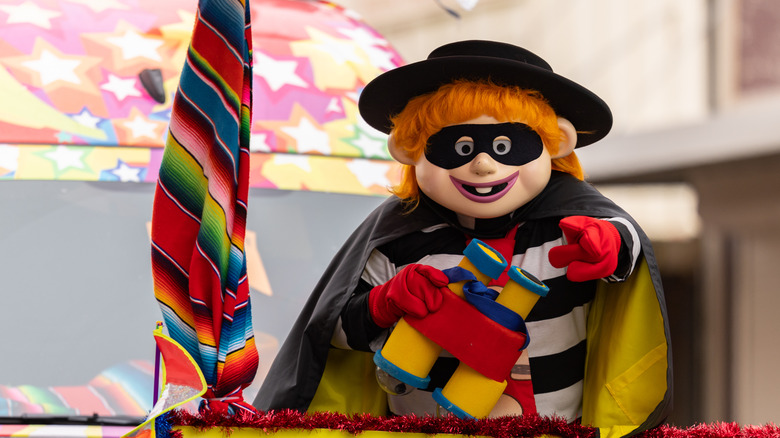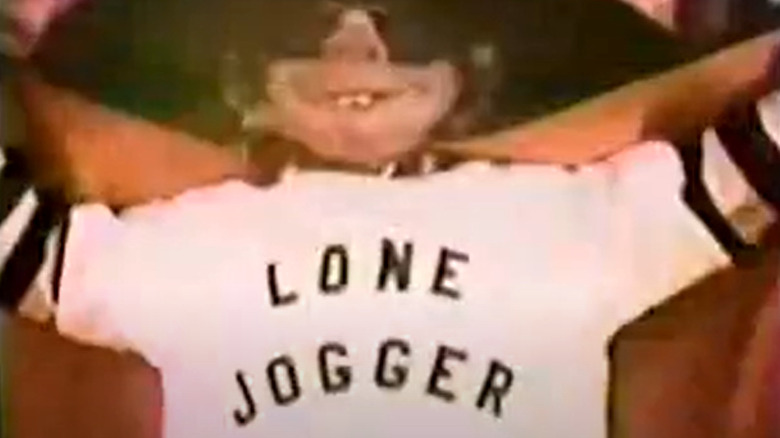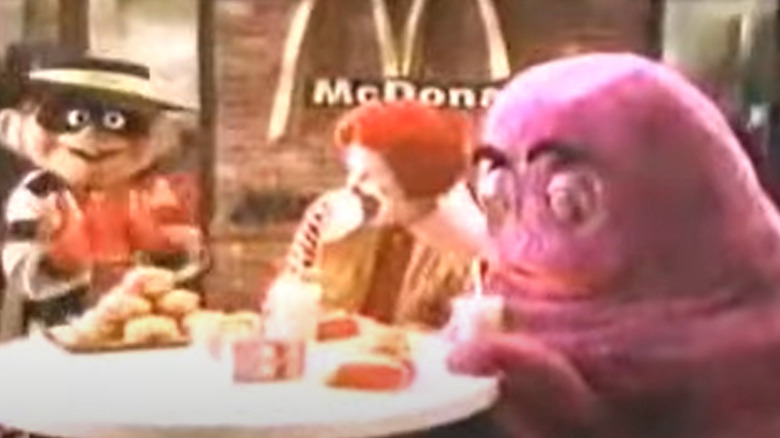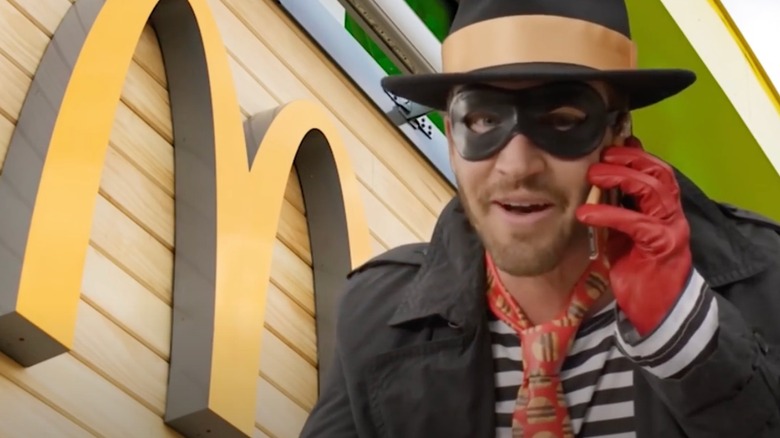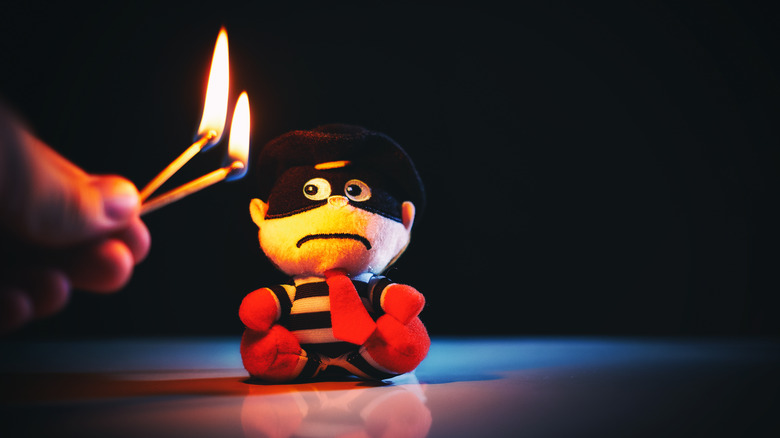Why McDonald's Really Got Rid Of The Hamburglar
No worries, kids. The big clown man is here to rescue your strangely flat and tepid burgers from the patty-pilfering, greasy gloves of the bobble-headed, bug-eyed, rabbit-toothed thief known as the Hamburglar. The big clown man Ronald and his cursed gumdrop, Grimace. Those characters, and that burger-headed dude with one cheese lip and that gang of sentient and armless pompoms with legs, and ... You know what, it's best not to investigate McDonald's character lore too deeply. Let's leave the fathomless depths of the nightmare realm alone.
Okay, maybe that's a bit of an exaggeration. But, the public's opinions of McDonald's mascots like the Hamburglar did change quite a bit from the burglar's initial 1971 launch to the present. Over time, the burglar gave off less "steal yo' kids' burgers" and more "steal yo' kids." That is, once the familiar mascot design got swapped out for the "hipster Hamburglar" circa 2015, as USA Today dubbed him. Who could have predicted that a stubble-faced dude approaching strangers while wearing a fedora, mask, and trench coat was a bad idea? Certainly not the execs at Mickey D's. That stubbled incarnation of the patty pilferer lasted until McDonald's adult-focused Sirloin Third Pound campaign ended.
Before that, the Hamburglar went through multiple iterations that changed with the times. Ultimately, the Hamburglar fell out of favor along with McDonald's itself in the early '00s when its nutritional quality and its desirability as a food franchise were called into question.
The original Hamburglar
For some readers, watching old McDonald's commercials from the '70s might evoke wistful feelings of childhood nostalgia. For everyone else, they're nightmare fuel and/or perfectly emblematic of how much the world and its perception of characters like the Hamburglar have changed. As CNN Money eventually quoted McDonald's executive officer Jim Cantalupo decades later in 2003 during the company's attempt to pivot towards a more mature image, "The world has changed. We have to change too."
Well before then we had the "Lone Jogger" in original 1970s ads – a dead giveaway regarding the Hamburglar's Lone Ranger inspiration, including his mask and cape. The Hamburglar appeared in ads wearing his Lone Jogger shirt along with his old-timey black-and-white-striped prisoner garb, sweeping into frame to tote away McDonald's hamburgers like a swashbuckling ne'er-do-well. With his crooked witch nose, buck teeth, and unmannerly behavior he acted as a kind of nemesis and foil to Ronald McDonald.
Such early ads featured kids hanging out at restaurant-like set pieces in a fantasy world of maximum burgers (and profit) dubbed "McDonaldland." The Hamburglar, along with other characters like the now-defunct Captain Crook, were developed as part and parcel of an entire, massive ad campaign meant to target kids and draw them into McDonaldland's deep-fried, real-world analog. In the '70s, these restaurants came equipped with slides, brightly-colored kids' tables, kiddie rides, etc. Such "PlayPlaces" have dwindled, but still exist. The Hamburglar was just another character meant to fill out the retinue, like Disney mascots at theme parks.
The famous 'robble, robble' era
In a way, the Hamburglar's most famous era presaged his demise, as he highlights a time when McDonald's pushed harder into the kid-friendly image that hamstrung it come the early '00s. This famous "robble, robble" Hamburglar era — the '80s and '90s — featured the revised, pudgy-faced, red-gloved version of the Hamburglar. But unlike his predecessor, the Hamburglar of this era didn't so much purloin the sirloin as obsess over it. Commercials from the time reveal that the Hamburglar traded in criminal thievery for pyramidal stacks of legally purchased burgers.
This dream of McDonald's overconsumption came true, as the company saw massive growth and global domination over the fast food market during the '80s and '90s. The chain was arguably at its peak during this time, outstripping Burger King, Wendy's, and other competitors to the point where it was commonly said that a new McDonald's opened every five hours worldwide. McDonald's diversified its menu to appeal to both adults and kids by introducing fish burgers, Chicken McNuggets, a greater variety of breakfast items, and so forth. But even though McDonald's aimed its sights at all ages, families with kids were the prime target.
This, plus McDonald's juggernaut status, is why the franchise drew the attention of health organizations. Such organizations dug into McDonald's poor nutritional profile even as animal rights organizations looked into the company's farm practices and environmental groups criticized its wasteful production process. Little did the Hamburglar know that he'd become a victim of McDonald's reforms.
I'm lovin' its new image
There are people young enough to not realize that the familiar "Ba da ba ba bah I'm lovin' it" jingle grew out of McDonald's Hamburglar-killing early '00s reforms. They also might not realize that Justin Timberlake sang the full version of the "I'm Lovin' It" track that got converted into the jingle. Also, they might not know who Justin Timberlake is. Such are the lessons of time's march that McDonald's learned ahead of conscripting the then-young singer/star to help overhaul their image come 2003.
Such reforms came on the heels of a major plummet in McDonald's stock in 2002, as a CNN Money report shows. The following year McDonald's announced its grand plan to glow-up its products and services a-la the aforementioned "The world has changed" quote from McDonald's executive officer Jim Cantalupo. In fact, McDonald's might have smelled the salad coming because the preceding years saw them buy out and/or partner up with burgeoning food brands like Chipotle (1998), Boston Market (2000), and largely UK-based Pret a Manger (2001) — though McDonald's let all of those go by 2008.
In 2004, the year after Justin Timberlake sang "Ba da ba ba bah," one of the most monolithically successful food-related documentaries of all time hit theaters: "Super Size Me." Now, folks had visible evidence of McDonald's nausea-and-obesity-inducing fast food fare. The Hamburglar wasn't exactly responsible for this reputation-damaging nightmare, but he wasn't needed for McDonald's success, either. It was time for him, McDonald's, and its burger-consuming public to grow up.
A new hamburglar for a new era
McDonald's quietly stowed the Hamburglar and its other characters in the early '00s in an attempt to keep up with evolving consumer trends, an increased public awareness related to nutrition, and a general desire for more upscale food options. McDonald's never announced, "We are no longer featuring the Hamburglar in our ads," they just stopped doing so. But, the burglar persisted in public consciousness, at least amongst those who'd grown up seeing him.
Enter the suburban dad version of the Hamburglar that "looks like he's having a midlife crisis," as Slate wrote in 2015. McDonald's marketing VP Joel Yashinsky told Mashable, "We felt it was time to debut a new look for the Hamburglar after he's been out of the public eye all these years. He's had some time to grow up a bit and has been busy raising a family in the suburbs and his look has evolved over time." Hence the "hide yo' kids hide yo' lunch" Hamburglar Halloween costume aesthetic. Some outlets seemed to be all about the look — including Entertainment Weekly and its "scruff, svelte, enviably stylish, arguably attractive manburglar" description — while also acknowledging that the character didn't really fit with anything related to McDonald's or fast food.
All in all, the revised Hamburglar wasn't exactly a winning marketing strategy. Memes from the time reveal his grade-A creep-o status amongst the general public. And like fries in a fryer, he was out as soon as he was in.
Bye bye burger burglar
A present, McDonald's is way past the point of their kid-focused '80s and '90s economic high as much as they're past the point of wielding the Hamburglar for marketing purposes. The burglar is a legacy character at this point, like Disney's Goofy or the Rescue Rangers. He'll never be completely abandoned, but he also won't be used, kind of like that one jar of pickles you don't eat, don't need, but occasionally remember took up residence in the back of your fridge.
In 2017, food industry analyst Andrew Alvarez told World Finance, "The country may not be getting healthier here in the U.S., but people are clearly more educated and aware of what they're putting in their mouths for the first time in a long time ... They are not interested in super salty foods anymore, in the same way that they were back in the 1980s and 1990s." That sums up one part of the equation nicely, along with the rise of more "boutique" fast food options like Shake Shack or chains with menus that are simpler and more streamlined than McDonald's, like Five Guys.
And even though McDonald's has faced increasing competition over the years, it still blows the competition out of the water in terms of money earned, with Starbucks being a distant second. More and more competitors continue to rise to power, like Chick-fil-A, but McDonald's still reigns supreme. We can't say for sure, but maybe the Hamburglar even helped a little.
